Unit 3 Flashcards - Behavior
1/67
Earn XP
Name | Mastery | Learn | Test | Matching | Spaced |
|---|
No study sessions yet.
68 Terms
Associative learning
General Conditioning Terms (these apply to both types of conditioning — Mods 26-28)
Definition: Learning certain events occur together. Events may be:
2 stimuli (classical conditioning)
A response and its consequence (operant conditioning
Acquisition
General Conditioning Terms (these apply to both types of conditioning — Mods 26-28)
In classical conditioning, it’s the initial state, when one links a neutral stimulus and an unconditioned stimulus so that the neutral stimulus begins triggering the conditioned response. In operant conditioning, it is the strengthening of a reinforced response.
Spontaneous recovery
General Conditioning Terms (these apply to both types of conditioning — Mods 26-28)
The reappearance of a weakened CR after a pause.
Ex: Pavlov allowed several hours to elapse before sounding the tone again. After the delay, the dogs began to salivate again to the tone. Suggested that extinction was suppressing the CR rather than eliminating it.
Generalization
General Conditioning Terms (these apply to both types of conditioning — Mods 26-28)
The tendency, once a response has been conditioned, for stimuli similar to the conditioned stimulus (CS) to elicit similar responses
Ex: In the Little Albert experiment, the baby became scared of all furry things, not just the white rat. He generalized his fear of white rats to all furry things.
Discrimination
General Conditioning Terms (these apply to both types of conditioning — Mods 26-28)
In classical conditioning, the learned ability to distinguish between a conditioned stimulus (CS) and similar stimuli that don’t signal an unconditioned stimulus (US).
Ex: In the Little Albert experiment, Watson could have trained Alber to discriminate the learning by giving him exposure to other furry things without the loud, while still presenting the white rat with the loud noise.
Respondent learning
Classical Conditioning Terms (mod 26, 28)
The acquisition of knowledge in responding to environmental signals. It’s a type of learning that happens when stimuli naturally produce a response, also called an unconditioned stimulus.
Unconditioned stimulus (US)
Classical Conditioning Terms (mod 26, 28)
In classical conditioning, a stimulus that unconditionally—naturally and automatically—triggers an unconditioned response (UR).
Ex: In the Pavolov dog experiment, the unconditioned stimulus is the food, as it causes an unconditioned response which is salivating.
Neutral stimulus (NS)
Classical Conditioning Terms (mod 26, 28)
In classical conditioning, a stimulus elicits no response before conditioning.
Ex: In Pavlov experiment, the neutral stimulus was the bell before acquisition.
Conditioned stimulus (CS)
Classical Conditioning Terms (mod 26, 28)
An originally neutral stimulus that, after association with an unconditioned stimulus (US) comes to trigger a conditioned response (CR)
Ex: In Pavlov dog experiment, the bell becomes a neutral stimulus as the dog associated the sound of the bell with the arrival of food. Now, just the tone elicits a conditioned response (salivation)
Unconditioned response (UR)
Classical Conditioning Terms (mod 26, 28)
An unlearned, naturally occurring response (such as salivation) to an unconditioned stimulus (US)
Ex: Salivation when seeing food.
Conditioned response (CR)
Classical Conditioning Terms (mod 26, 28)
A learned response to a previously neutral (but now conditioned) stimulus.
Ex: Pavlov dog experiment, salivating to tone after making the association.
Delayed conditioning
Classical Conditioning Terms (mod 26, 28)
One of the four ways to conduct classical conditioning. NS first and continues when US is presented. It is the best way to conduct classical conditioning!
Ex: In the Pavlov dog experiment, it could’ve been that he kept ringing the bell after bringing in the food.
Trace conditioning
Classical Conditioning Terms (mod 26, 28)
One of the four ways to conduct classical conditioning. Present NS first, with a brief pause, and present US. Is the second-best.
Ex: In the Pavlov dog experiment, it could be that he brings the bell, pauses, and then brings out food.
Simultaneous conditioning
Classical Conditioning Terms (mod 26, 28)
One of the four ways to conduct classical conditioning. Present NS and US at exact same time.
Ex: In Pavlov's dog experiment, it could be that he rings the bell as the food is presented.
Backward conditioning
Classical Conditioning Terms (mod 26, 28)
One of the four ways to conduct classical conditioning. Us is first, followed within second by NS. Doesn’t work.
Ex: In Pavlov’s dog experiment, it could be that he brings the food out first and then rings the bell.
Aversive conditioning (Aversion therapy)
Classical Conditioning Terms (mod 26, 28)
A type of behavior conditioning in which harmful stimuli are associated with undesirable or unwanted behavior that is to be modified or abolished.
Ex: Fast food video, lady getting shocked every time she tries to eat fast food. The shock made her recoil and make the association of fast food with pain. US: Electric shock, UR: Pain, NS, CS: fast food, Cr: Fear of pain from shock
Second order (higher order) conditioning
Classical Conditioning Terms (mod 26, 28)
A procedure in which the conditioned stimulus in one conditioning experience is paired with a new neutral stimulus, creating a second (often weaker) conditioned simuls.
Ex: an animal that has learned that a tone predicts food might then learn that a light predicts the tone, and begin responding to the tone alone. Light—>tone —>food.
Learned taste aversion (Garcia effect)
Classical Conditioning Terms (mod 26, 28)
After someone has eaten something that makes them sick, they don’t want to eat it anymore—they find it repugnant. Has to be biologically and logically relevant to create a reaction—for survival.
Ex: Garcia & Koelling rats studies
Pavlov and the salivating dogs
Classical Conditioning people/research (mod 26, 28)
Studied effects of the external environment on reflex responses, in this case, he classically conditioned dogs to salivate to the sound of a bell. He knew that the sight of food naturally causes a salivating reaction, however, there was no salivating response to the sound of the bell. he then presented the bell with the food several times causing the dog to make the association of the bell meaning food, causing salivation.
NS: Bell (@ 1st)
US: Food
UR: Salivation
After conditioning:
CS: Bell
CR: Salivation
Mnemonic: Pavlov’s salivating dogs… that rings a bell!
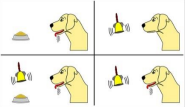
Watson & Rayner Little Albert study
Classical Conditioning people/research (mod 26, 28)
Wanted to see if they could make a baby fear a rat, when normally babies aren’t. Baby is scared of loud noises so they air the loud noise whenever the baby is with a white rat. The baby learns to associate that seeing the white rat will be accompanied by the loud noise so he learns to fear the rate. Not only is he scared of the rat, but he generalizes his fear to all furry things.
NS: WHite rat (@ 1st)
US: Loud noise
Ulways (always) means…
UR: Crying, crawling away (fear response)
After conditioning:
CS: White rat, all furry things
CR: Crying, crawling away (Fear response)
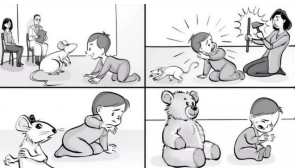
Garcia and learned taste aversion, Garcia & Koelling rats studies
Classical Conditioning people/research (mod 26, 28)
While researching the effects of radiation on lab animals, Garcia and Koeeling noticed that the rats began to avoid drinking water from the plastic bottles in radiation chambers. Could they be classical conditioning?
To test it they exposed rats to sweet water or a loud noise (NS/CS) that was paired with either a shock or radiation (US) that led to nausea and vomiting (UR).
After getting sick after tasting a particular flavor, the rats avoided that flavor. Sickened rats developed an aversion to tastes (taste aversion) but not sights or sounds. Showed that the CS has to be biologically and logically relevant to create a reaction—for survival.
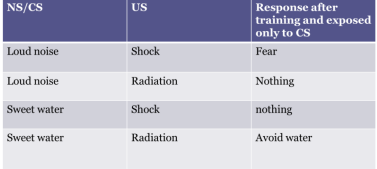
Domjan male quial ‘red light’ experiment
Classical Conditioning people/research (mod 26, 28)
Made quail’s associated red light with horniness by placing a female quail in heat in a room with a red light at the same time. The male quail then has increased semen production to the red light alone.
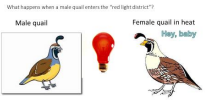
Fazio Pokemon experiment
Classical Conditioning people/research (mod 26, 28)
They paired the character Pichu with the word evil and Pikachu with sweet. When later asked about their feelings towards the character, they had negative reactions to Pichu and positive reactions to Pikachu.
When words that elicit positive or negative emotions are repeatedly paired with ideas or images, we become conditioned to have positive or negative instinctive reactions to those ideas or images. We make implicit associations unconsciously.

Rescorla contingency theory
Classical Conditioning people/research (mod 26, 28)
Showed that an animal can learn the predictability of an event. If a shock is preceded by a tone, and then also by a light, a rat will react with fear to the tone but not the light. Although the light is always followed by a shock, it adds no new info; tone is a better predictor.
Predictability is more important than the frequency of pairings.
Law of effect
Operant Conditioning Terms (mod 27, 28)
Formal definition: Consequence of one’s behaviors is instrumental to shaping FUTURE behaviors.
Meaning that we learn from the consequences of our actions. If the consequence is good, we are likely to do it again. If the consequence is bad, we are not likely to do it again.
Instrumental learning
Operant Conditioning Terms (mod 27, 28)
A type of learning in which behaviors are strengthened or weakened by their consequences.
Reinforce (R)
Operant Conditioning Terms (mod 27, 28)
Strengthens a response of behavior.
Punishment (P)
Operant Conditioning Terms (mod 27, 28)
Weakens or extinguishes a response/behavior
Negative and positive R/P
Operant Conditioning Terms (mod 27, 28)
Positive adds something and negative takes something away. Positive reinforcement is adding a reward (ex: Big Bang Theory Penny getting chocolate, Penny is more likely to do what Sheldon wants), negative reinforcement takes away a yucky stimuli (ex: taking medicine to take the pain away, more likely to do it again in the future when in pain). Postive punishment is adding a bad condition (ex: dog being naughty and getting sprayed with water, dog is less likely to do that bad behavior again), negative punishment takes away a good condition (ex: teen obsessed with phone getting phone taken away for bad grades, teen will try to get their grades up again)

Avoidance learning
Operant Conditioning Terms (mod 27, 28)
The process of learning to employ avoidance behaviors in certain circumstances.
Ex: Person who gets allergic reaction from eating a certain food eventually will learn to avoid that food and not eat it at all.
Escape learning
Operant Conditioning Terms (mod 27, 28)
A type of negative reinforcement in which one distances themself once they are presented with an undesirable stimulus or preforms a behavior to stop that stimulus once it begins to occur.
Ex: Kid going to the bathroom to escape a class they don’t like.
Omission training
Operant Conditioning Terms (mod 27, 28)
A positive event/something the subject enjoys is taken away as punishment for an action or behavior. Is done in hopes to prevent action/behavior from occurring again.
Ex: Loss of one’s diver’s license for getting too many speeding tickets.
Shaping
Operant Conditioning Terms (mod 27, 28)
Procedure in which reinforces guide behavior towards closer and closer approximations of the desired behavior.
Chaining
Operant Conditioning Terms (mod 27, 28)
Steps with feedback to shape behavior
Ex: Dogs learning to drive, chicken obstacle course.
Operant chamber (Skinners box)
Operant Conditioning Terms (mod 27, 28)
A chamber containing a bar or key that an animal can manipulate to obtain a food reinforcer; attached devices record the anima’s rate of bar pressing or key pecking.
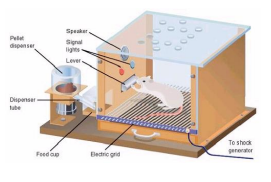
Primary reinforcer
Operant Conditioning Terms (mod 27, 28)
An innately reinforcing stimulus, such as one that satisfies a biological need—unlearned.
Ex: food and water
Secondary reinforcer (conditioned reinforcers)
Operant Conditioning Terms (mod 27, 28)
Get their power through learned association with primary reinforces. Not biological, it has meaning because it has social meaning.
Ex: If a rat in Skinner’s box learns that a light reliable signals a food delivery, the rat will turn on the light. The light has become a secondary reinforcer.
Generalized reinforcer
Operant Conditioning Terms (mod 27, 28)
A consequence that has been paired with access to many reinforcing consequences until it took on reinforcing properties itself.
Ex: Money is a generalized secondary reinforcer because it can you any primary and secondary reinforcer things.
Token economy
Operant Conditioning Terms (mod 27, 28)
Procedure in which people earn a token of some sort for exhibiting a desired behavior and can later exchange the tokens for various privileges or treats.
Ex: token economy in schools/classroom: in my school they did class dojo points, and if you got enough you could get things like a pizza party.
Reinforcement schedules
Operant Conditioning Terms (mod 27, 28)
A pattern that defines how often a desired response will be reinforced. Include continuous reinforcement. And Skinner’s schedules of partial reinforcement: Fixed-ratio reinforcement, variable-ratio reinforcement, fixed-interval reinforcement, variable-interval reinforcement.
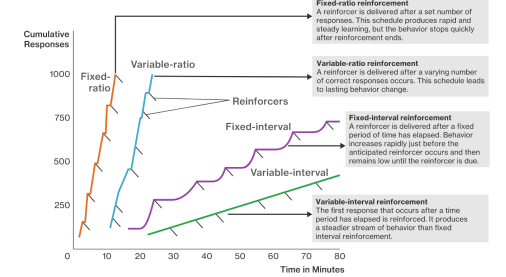
Fixed-ratio reinforcement
A reinforcer is delivered after a set number of responses. This schedule produces rapid and steady learning, but the behavior stops quickly after reinforcement ends.
Ex; everytime rat pulls level exactly 5 times, it gets food.
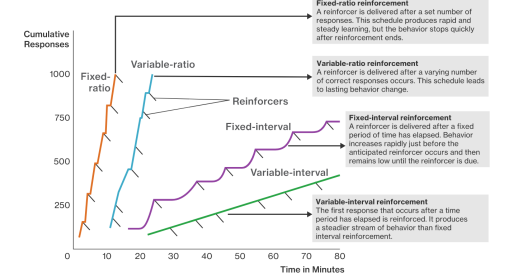
Variable ratio-reinforcement
A reinforcer is delivered after a varying number of correct responses occurs. This schedule is the most effective.
Ex: slot machines at casinos
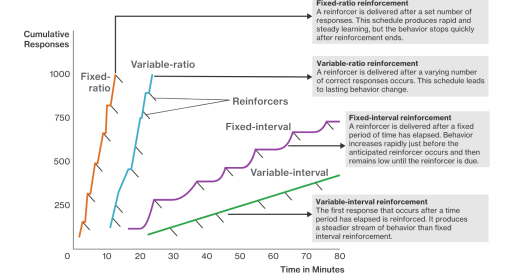
Fixed-interval reinforcement
A reinforcer is delivered after a fixed period of time has elapsed. Behavior increases rapidly just before the anticipated reinforcer occurs and then remains low until the reinforcer is due.
Ex: A teacher giving a reward for good behavior each class.
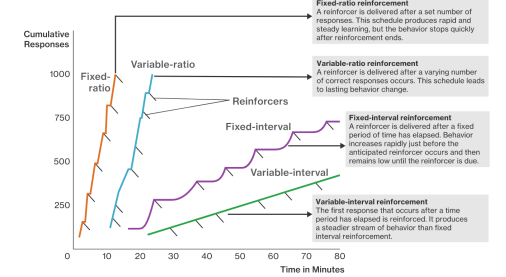
Variable-interval reinforcement
The first response that occurs after a time period has elapsed is reinforced. It produces a steadier stream of behavior than fixed interval reinforcement. After some time.
ex: An employer checking your work, dropping by a few times a day to check your progress,
Partial-reinforcement effect
Operant Conditioning Terms (mod 27, 28)
Reinforcing a response only part of the time; results in slower acquisition of a response but much greater resistance to extinction than does continuous reinforcement.
Instinctive drift
Operant Conditioning Terms (mod 27, 28)
Tendency of learned behavior to gradually revert to biologically predisposed patterns.
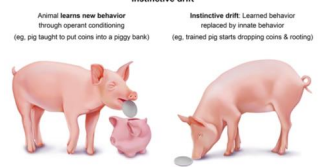
B.F. Skinner pigeon studies
Operant Conditioning People/research (mod 27, 28)
An experimental project to create pigeon-guided missiles. the pigeons were trained by Skinner to peck at a target, and they rewarded with food when they completed the task correctly. Abstract learning
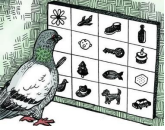
E. Thorndike
Operant Conditioning People/research (mod 27, 28)
Contribution to psych was law of effect: The consequence of one’s behavior is instrumental to shaping FUTURE behaviors.
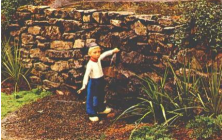
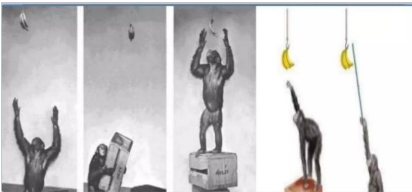
Insight learning
Biology, cognition, and learning (mod 29)
The sudden realization of a problem’s solution. An “AHA!” moment.
Ex: Chimps filling the tube with water to get the peanut from the bottom when they made the connection that things float in water, Or Wolfgang Kohler chimp studies.
Abstract learning
Biology, cognition, and learning (mod 29)
Idea that we learn about concepts and categories.
EX: This can be found in pigeons when teaching them concepts. They distinguish and make connections, peck when they see a image with a common theme.
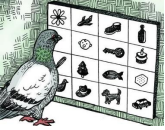
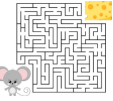
Latent learning — E. Toleman rats and maze study
Biology, cognition, and learning (mod 29)
Learning occurs but is not apparent until there is an incentive to demonstrate it.
Ex: E. Tolman rats and maze study: after rats found out by themselves that there was food at the end of the maze, they began to form cognitive maps and demonstrate latent learning by completing the maze faster and faster each day.
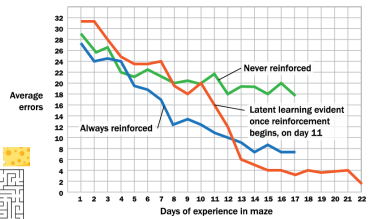
Intrinsic motivation
Biology, cognition, and learning (mod 29)
Intrinsic motivation: The desire to perform a behavior effectively and for its own sake.
Ex: participating in a sport because it’s fun and you enjoy it rather than doing it to win an award.
Extrinsic motiavtion
Biology, cognition, and learning (mod 29)
Extrinsic motivation: behaving in ways that gain external rewards or avoid punishment.
Ex: Doing well in an AP class for test to get college credit.
Overjustification effect
Biology, cognition, and learning (mod 29)
Our tendency to become less intrinsically motivated to partake in an activity that we used to enjoy when offered an external incentive such as money or a reward.
Ex; Kids getting paid to play with a toy they lie, might grow to dislike it.
Problem-focused coping
Biology, cognition, and learning (mod 29)
Attempting to alleviate stress directly by changing the stressor or the way w interact with that stressor. The problem can be solved, worked on.
Ex: Impatience leads to a family fight, we may go directly to that family member to work things out.
Emotion-focused coping
Biology, cognition, and learning (mod 29)
Attempting to alleviate stress by avoiding or ignoring the stressor and attending to emotional needs related to our stress reaction. The problem can’t be solved.
Ex: Can’t get along with significant other, may go to mom for support and comfort.
Learned helplessness — Seligman dog experiment
Biology, cognition, and learning (mod 29)
Hopelessness and passive resignation an animal or person learns when unable to avoid repeated aversive events.
Uncontrollable bad events—>perceived lack of control—> generalized helpless behavior.
Seligman dog experiment, condition one has a dog on a grid floor with a plank with something in the middle. One side has bards that will electrify the food, and the other side the dog will be safe from shock. The light dims, warning the dog of the impending shock. Once the dog realizes that one side shocks them, they go to the other side where they are safe. However, condition 2 has the same conditions except this time the dog can’t escape the shock, at first the dog tries to escape, but once they realize they can’t do anything about it they give up. This is called learned helplessness because they learn to just accept it
Ex: Abusive relationships
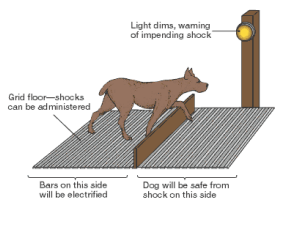
Internal locus of control
Biology, cognition, and learning (mod 29)
The perception that we control our own fate. Free will.
external locus of control
Biology, cognition, and learning (mod 29)
The perception that chance or outside forces beyond our personal control determine our fate.
Self-control
Biology, cognition, and learning (mod 29)
Ability to control impulses and delay short-term gratification for greater long-term rewards
Ex: Marshmellow test.
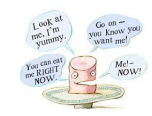
Observational learning (social learning)
Observational Learning (mod 30)
Learning by observing others.
Mnemonic: Monkey see, monkey do.
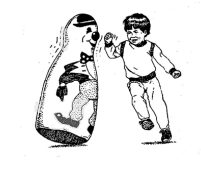
Bandura’s Bobo doll study
Observational Learning (mod 30)
Kids would watch a video of a lady hitting/punching a Bobo doll before entering a playroom. When they went inside they ignored all other toys and went for the Bobo doll to model the lady in the video. The kids to watched the video even reached for a gun.
DV: how much kids imitate
IV: whether the kids were exposed to an aggressive or passive role model
Showed that viewing aggression increases the desire to be violent.
Explained how when kids grow up with abuse they have more aggression when they're older.
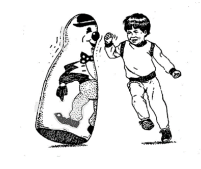
Vicarious learning
Observational Learning (mod 30)
A way of learning that allows individuals to learn from the experience of others. It is a conscious process that involves sensing, feeling, and empathizing with what people are doing and evaluating.
Ex; reading a book and hearing stories
Modeling
Observational Learning (mod 30)
Process of observing and imitating a specific behavior.
Ex: Albert Bandura’s Bobo doll experiment
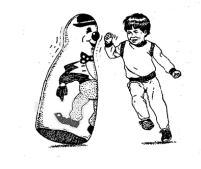
Mirror neurons
Observational Learning (mod 30)
Frontal lobe neurons that some scientists believe fire when we perform certain actions or observe another doing so. The brain’s mirroring of another’s action may enable imitation and empathy.
Ex: monkey watching human eat an ice cream/peanut while frontal lobe was being monitored (the region that enabled the monkey to plan and enact movements). As the monkey watched the human lick the ice cream, the monkey’s monitor buzzed—as if the motionless monkey had moved
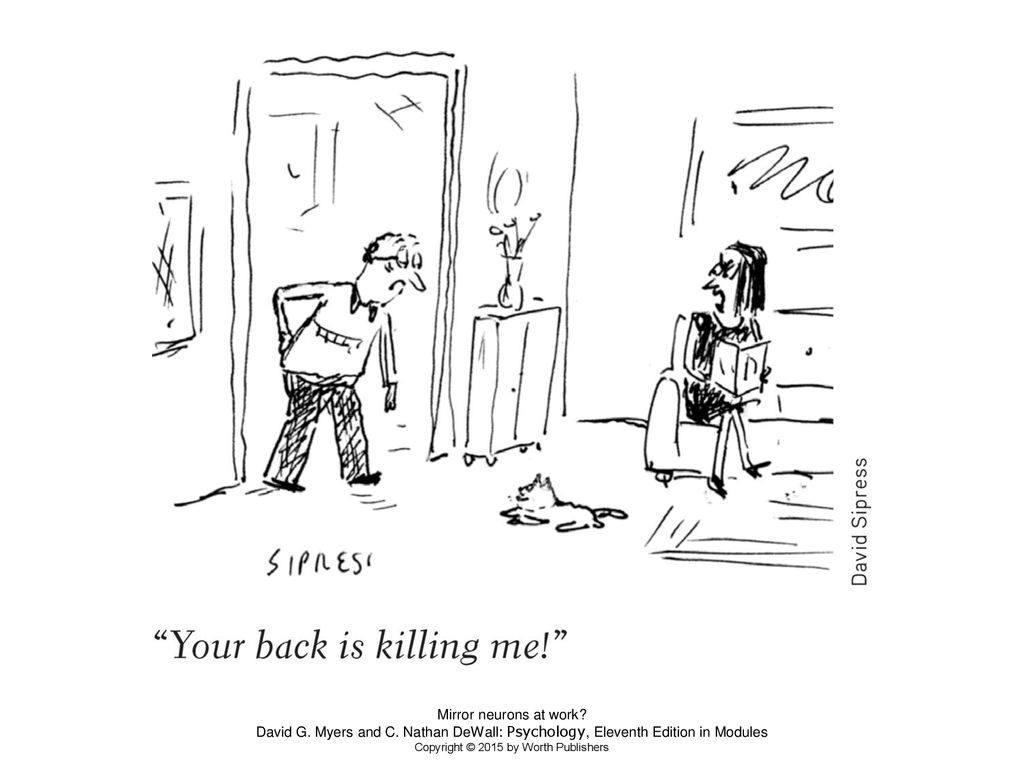
Empathy
Observational Learning (mod 30)
the cognitive and emotional reactions of an individual to the observed experiences of another.
Prosocial behavior
Observational Learning (mod 30)
Positive, constructive, helpful behavior.
Ex: Volunteer work or donating money
antisocial behavior
Observational Learning (mod 30)
A particularly challenging type of personality disorder characterized by impulsive, irresponsible and other criminal behavior.
Ex: Stealing or physical assault